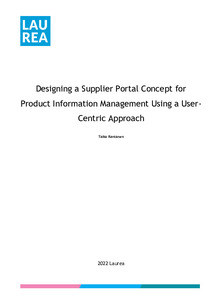Designing a Supplier Portal Concept for Product Information Management Using a User-Centric Approach
Rantanen, Taika (2022)
Rantanen, Taika
2022
All rights reserved. This publication is copyrighted. You may download, display and print it for Your own personal use. Commercial use is prohibited.
Julkaisun pysyvä osoite on
https://urn.fi/URN:NBN:fi:amk-2022113025323
https://urn.fi/URN:NBN:fi:amk-2022113025323
Tiivistelmä
The digital era has revolutionized the retail business environment, where digital product information has become the enabler for various business activities. The rise of e-commerce is one of the main drivers for companies to invest in product information management systems and processes as it sets high requirements for product information quality and consistency. Retail supply chain actors share product information between each other as a part of their business actions, but they also have different product information related requirements, systems, and practices. This results in practical challenges and manual work when product information needs to be shared between organizations. On the other hand, intentional differentiation of product information such as search engine optimization (SEO) can also be used as a source of competitive advantage.
This thesis was commissioned by a Finnish-based trading company. The purpose of this thesis was to improve the fluency of product information sharing in the supply chain between product suppliers and the case company. The objective was to design a concept for a supplier self-service portal for product information management and to identify Minimum Viable Service requirements. The theoretical framework of this thesis consists of Service-Dominant Logic, Service Logic, and value creation in service process.
The empirical part of the thesis is a case study, which utilizes design thinking, service design methods and user-centered approach to digital service development. The empirical process follows the Double Diamond design process model developed by Design Council. Six case company employee interviews, six supplier employee interviews and a focus group with case company employees were conducted to discover the service context and user needs. A learning story was written to benchmark a previously used system. User needs were crystallized in the form of three user personas. A service proposition was drafted based on the research and refined based on user feedback.
The main empirical outcome is a Service Concept for a supplier portal for product information management, which emphasizes aspects of collaboration. Three service blueprints were drawn to visualize the Minimum Viable Service requirements. Eventually, the process of delivering the design from a concept-level to software developers was established utilizing user stories as a means to document development specifications.
As a result of applying design thinking and focusing on the problem definition in the empirical part of the thesis, the design challenge became refined and user centric. The main conclusion of the thesis was that a supplier portal for product information management could benefit both the case company and its suppliers by facilitating their collaboration in the complex context of product information management and information sharing.
This thesis was commissioned by a Finnish-based trading company. The purpose of this thesis was to improve the fluency of product information sharing in the supply chain between product suppliers and the case company. The objective was to design a concept for a supplier self-service portal for product information management and to identify Minimum Viable Service requirements. The theoretical framework of this thesis consists of Service-Dominant Logic, Service Logic, and value creation in service process.
The empirical part of the thesis is a case study, which utilizes design thinking, service design methods and user-centered approach to digital service development. The empirical process follows the Double Diamond design process model developed by Design Council. Six case company employee interviews, six supplier employee interviews and a focus group with case company employees were conducted to discover the service context and user needs. A learning story was written to benchmark a previously used system. User needs were crystallized in the form of three user personas. A service proposition was drafted based on the research and refined based on user feedback.
The main empirical outcome is a Service Concept for a supplier portal for product information management, which emphasizes aspects of collaboration. Three service blueprints were drawn to visualize the Minimum Viable Service requirements. Eventually, the process of delivering the design from a concept-level to software developers was established utilizing user stories as a means to document development specifications.
As a result of applying design thinking and focusing on the problem definition in the empirical part of the thesis, the design challenge became refined and user centric. The main conclusion of the thesis was that a supplier portal for product information management could benefit both the case company and its suppliers by facilitating their collaboration in the complex context of product information management and information sharing.
